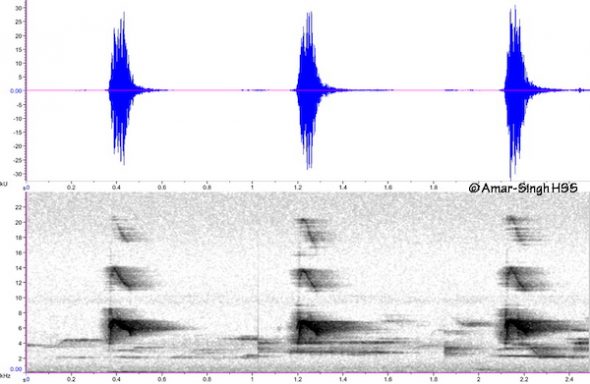The song and calls of the Copper-throated Sunbirds (Leptocoma calcostetha) are not well described. Wells (2007) says “A disyllable somewhat like the Brown-throated Sunbird, but no more detail available, and songs undescribed”. Cheke & Mann (2001) state “A deep trill, more melodious and less descending than the Yellow-bellied Prinia…”. Handbook of the Birds of the World Alive (2020) summarises both records and says “Utters both a high trill, and a deep melodious trill; also, a disyllabic call resembling that of Anthreptes malacensis”.
I made 9 call and song recordings of a number of birds over a 4+ hour period.
The calls/songs made by males include:
- A single, sharp, high frequency (20-21 kHz), brief (0.1-0.15 seconds) call, This call is almost not perceptible to me due to age related high tone hearing loss; hence may be missed by bird watchers. This is the commonest call made by adult males and also used territorially and in flight. It is used repeatedly 1-4 seconds apart for some time. Below is the sonogram and waveform of this call.

- The less common call heard was the one referred to as a ‘disyllabic call’ in literature. To my ears this is a single note call, lasting 0.3 seconds and is sort of a ‘pleading’ call (16-17 kHz). It does resemble the call used by the Brown-throated Sunbird. It was made 2-4 seconds apart, at rest, with a female in attendance. Below contains the sonogram and waveform of this call.

3. The third call is what I would consider the bird’s song. It was made not infrequently both at rest as well as when moving about (below). The song lasts 1.5-2 seconds and is a high frequency (20-21 kHz), has 9-14 notes sung rapidly. I presume this is the one referred to as a ‘trill’. Below are the sonogram and waveform of this call.

- The final song/call was heard infrequently and is a drawn-out chatter of numerous notes uttered in 4-5 seconds of varying frequencies. Below show the sonogram and waveform of this call.

Calls/song described in the above three can be heard in this recording: https://www.xeno-canto.org/592634
Calls described in the last is found at the end of this recording. The earlier part has the first call: https://www.xeno-canto.org/592635
References:
- Wells, D.R. (2007). The birds of the Thai-Malay Peninsula: Vol. 2 (Passerines). Christopher Helm, London.
- Robert A Cheke, Clive F Mann, Richard Allen (2001). Sunbirds: A Guide to the Sunbirds, Flowerpeckers, Spiderhunters and Sugarbirds of the World. Helm Identification Guides
- Cheke, R. & Mann, C. (2020). Ruby-cheeked Sunbird (Chalcoparia singalensis). In: del Hoyo, J., Elliott, A., Sargatal, J., Christie, D.A. & de Juana, E. (eds.). Handbook of the Birds of the World Alive.
Amar-Singh HSS (Dato’ Dr)
Ipoh, Perak, Malaysia
Location: Bagan Datuk, Perak, Malaysia
Habitat: Mangrove forest
Date: 10th September 2020
Equipment: Equipment: Nikon D500 SLR with Nikon AF-S Nikkor 500mm f/5.6E PF ED VR, handheld with Rode VideoMic Pro Plus Shotgun Microphone








